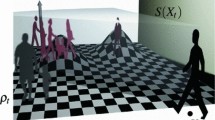Abstract
This paper reports observations of passenger flow in the Wuchang railway station in Wuhan, China during the Chinese Traditional Spring Festival in 2006. The data collected are used to verify a crowd dynamics model previously developed. The crowd dynamics model is based on simulating the global movement of each individual under the influence of the surrounding crowd, and the good agreement between the predictions and observations validates the prediction model. The crowd dynamics model suggests that the crowd movement speed is dominated by two factors: the front-back inter-person effect, and the pedestrian’s self-motive. The first effect gives logarithmic relationship between the crowd speed and crowd density. The second factor depends on the individual motive driven with which people try to divorce themselves from the control of the crowd movement. The prediction model are helpful to guide the design of public traffic systems for effective crowd dispersal.
Similar content being viewed by others
References
Li J L. The Fire in Dong Du Building in LuoYang[N]. People Daily, 2000-12-26(Ch).
Lo S M, Fang Z. A Spatial-Grid Evacuation Model for Building[J]. Journal of Fire Science, 2000, 18(3):376–394.
Gwynne S, Galea E R, Owen M. Investigation of the Aspects of Occupant Behavior Required for Evacuation Modeling[J]. Journal of Applied Fire Science, 1999, 8(1):19–59.
Fruin J. Metropolitan Association of Urban Designers and Environmental Planners[M]. New York: ASCE Press, 1971.
Predtechenskii V M, Milinski A I. Planning for Foot Traffic Flow in Building[M]. Moscow: Stroiizdat Publishers, 1969.
Polus A, Schofer J L, Ushpiz A. Pedestrian Flow and Level of Service[J]. Transportation Engineering, 1983, 109(4): 46–57.
Ando K, Ota H, Oki T. Forecasting the Flow of People[J]. Railway Research Review, 1988, 45(8): 8–14.
Pauls J, Nelson H E, Maclennan H A. The SFPE Handbook of Fire Protection Engineering [M]. Massachusetts: NFPA, 1995.
Smith R A. Density Velocity and Flow Relationships for Closely Packed Crowds[J]. Safety Science, 1995, 18(6): 321–327.
Thompson P A, Marchant E W. Computer and Fluid Modelling of Evacuation[J]. Safety Science, 1995, 18(8): 277–289.
Wang Houhua, Guo Dan, Guo Yong. Research on the Prediction of Evacuation Action Time for Personnal in Building[J]. China Safety Science Journal, 2006, 16(11): 54–58(Ch).
Cui Xihong, Li Qiang, Chen Jin. Study on Occupant Evacuation Model in Large Public Place: to Consider Individual Character and Following Behavior[J]. Journal of Natural Disaters, 2005, 14(6): 133–140(Ch).
Chu Guanquan, Sun Jinhua. Pre-Evacuation Time for Occupants and Its Effect on Fire Risk Assessment [J]. Journal of Safety and Environment, 2005, 5(3): 102–105(Ch).
Fang Z, Lo S M, Lu J A. On the Relationship between Crowd Density and Movement Velocity[J]. Fire Safety Journal, 2003, 38(4): 271–283.
Lee D, Park J H, Kim H. A Study on Experiment of Human Behavior for Evacuation Simulation[J]. Ocean Engineering, 2004, 31(2): 931–941.
Roytman M Y. Principles of Fire Safety Standards for Building Construction[M]. New Delhi: Amerind Publishing Company, 1975.
Author information
Authors and Affiliations
Corresponding author
Additional information
Foundation item: Supported by the National Natural Science Foundation of China (50478057) and the Key Technologies Research and Development Program of Hubei Provice (2004AA30B05)
Biography: YUAN Jianping (1980–), male, Ph.D. candidate, research direction: building fire safety, crowd evacuation.
Rights and permissions
About this article
Cite this article
Yuan, J., Fang, Z., Lo, S. et al. Observations of passenger flow and verification of a crowd dynamics model. Wuhan Univ. J. Nat. Sci. 13, 195–200 (2008). https://doi.org/10.1007/s11859-008-0213-2
Received:
Published:
Issue Date:
DOI: https://doi.org/10.1007/s11859-008-0213-2




